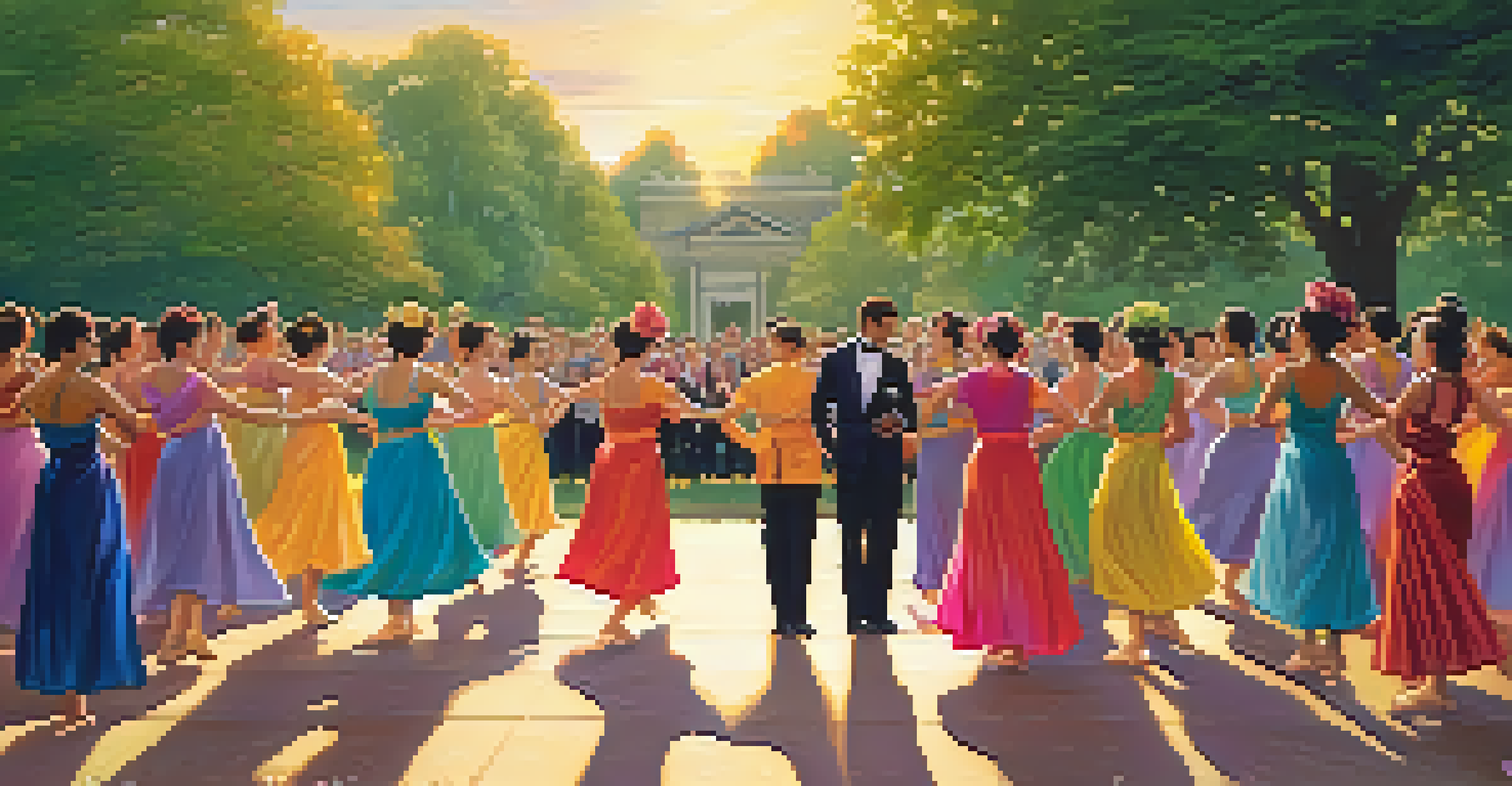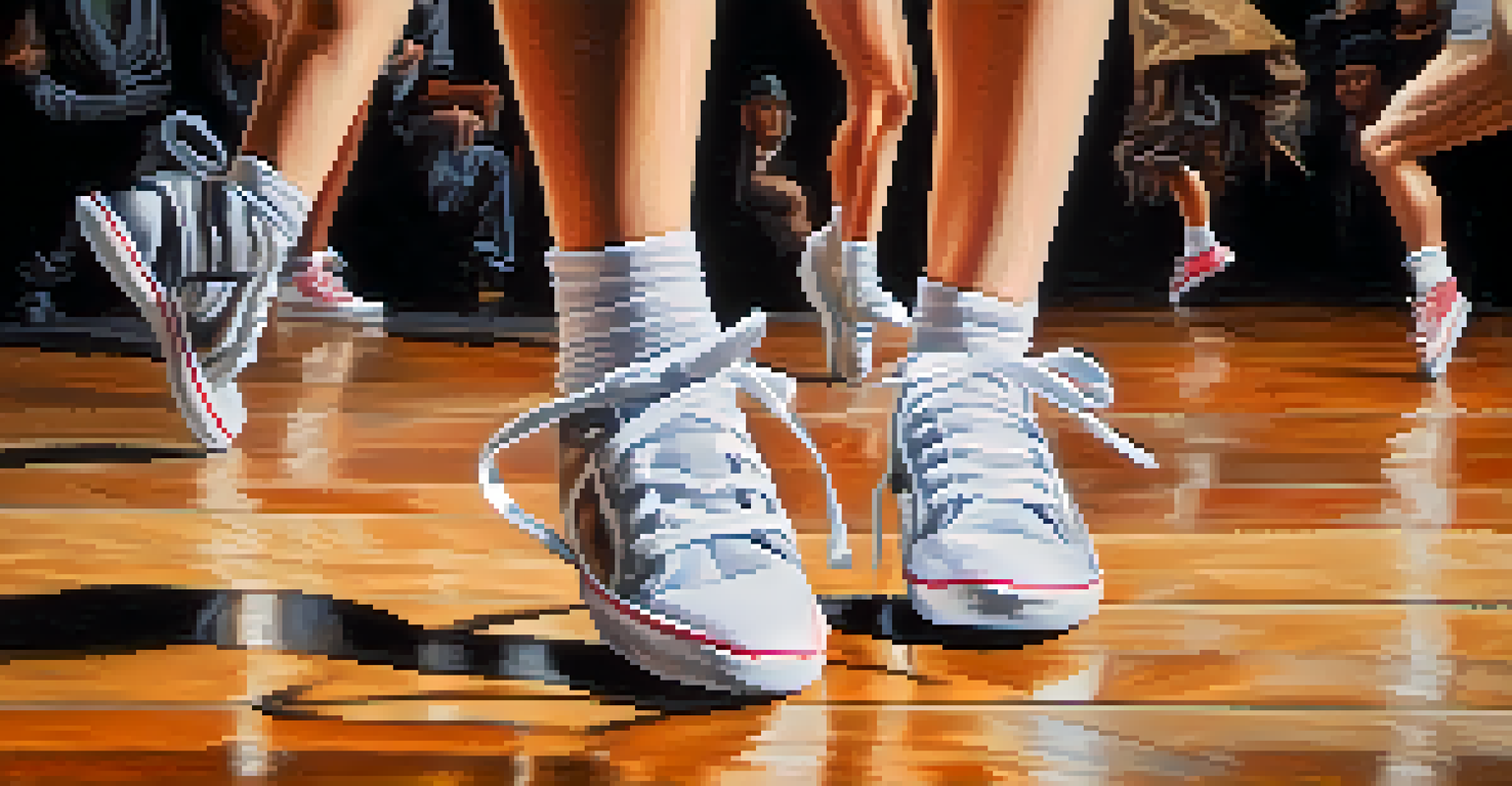Breaking Stereotypes: Dance as a Tool for Gender Fluidity

Understanding Gender Fluidity Through Dance
Gender fluidity is a concept that embraces a spectrum of gender identities beyond the traditional binary of male and female. Dance, with its expressive nature, allows individuals to explore and express these identities freely. Through movement, dancers can challenge societal norms and convey their unique experiences, making dance a powerful tool for self-discovery.
Dance is the hidden language of the soul.
For instance, a dancer who identifies as non-binary may choose to perform in ways that blend traditionally masculine and feminine styles. This can create a visual representation of their identity, inviting audiences to reconsider their own perceptions of gender. By breaking away from conventional choreography that often reinforces stereotypes, dancers can show the beauty in fluidity.
Moreover, dance can foster a sense of community among those exploring gender fluidity. Classes and performances dedicated to this theme provide safe spaces for individuals to connect and share their journeys. Such interactions can be transformative, as they encourage acceptance and understanding both within and outside the LGBTQ+ community.
Historical Context: Dance and Gender Norms
Throughout history, dance has often mirrored societal expectations around gender. From classical ballet, which typically featured gender-specific roles, to traditional folk dances with strict male and female pairings, these art forms have perpetuated stereotypes. However, the evolution of dance has opened doors for challenging these norms.

Consider the rise of contemporary dance in the late 20th century, which began to prioritize individual expression over adherence to traditional roles. Choreographers like Martha Graham and Pina Bausch explored themes of identity, breaking away from the confines of gender-specific movements. Their innovative approaches have paved the way for a more inclusive understanding of what dance can represent.
Dance as Self-Expression
Dance allows individuals to explore and express their gender identities, challenging societal norms through movement.
As cultural shifts continue to influence dance, performers now have more freedom to explore their identities without the weight of historical constraints. This evolution signifies a broader acceptance of diverse gender expressions within the art form, leading to a more dynamic and representative dance landscape.
Dance Styles Embracing Gender Fluidity
Various dance styles have become platforms for expressing gender fluidity, each bringing its unique flavor to the conversation. Styles like hip-hop and street dance often encourage a blend of movements that defy traditional gender roles, allowing dancers to showcase their individuality. The improvisational nature of these genres particularly supports fluid expressions of gender identity.
We’re all made of stardust. We are all made of the same stuff, and we are all different, and that’s what makes the universe beautiful.
In contrast, ballroom dancing has historically been divided into male and female roles. However, recent trends have emerged that challenge this binary system, with same-gender partnerships gaining visibility. This shift not only validates the experiences of LGBTQ+ dancers but also enriches the art form by introducing diverse interpretations of lead and follow roles.
Additionally, styles like voguing, which originated in the LGBTQ+ ballroom scene, emphasize self-expression and the celebration of identity. Voguing challenges conventional beauty standards and embraces a spectrum of gender presentations, making it a vibrant example of how dance can serve as a medium for exploring fluidity.
The Role of Social Media in Dance and Gender Fluidity
Social media has become a powerful vehicle for dancers to share their experiences and challenge gender norms. Platforms like Instagram and TikTok allow dancers to showcase their talents and express their identities to a global audience. This exposure can foster acceptance and inspire others to embrace their own fluidity through dance.
In recent years, viral dance challenges have highlighted diverse expressions of gender, encouraging participants to move beyond traditional expectations. For example, the popularity of gender-neutral choreography invites dancers of all identities to join in, creating a sense of belonging and community. Such movements can spark conversations about gender fluidity in broader contexts.
Breaking Gender Norms
Historical dance practices have often reinforced gender roles, but contemporary styles now encourage fluidity and inclusivity.
Moreover, social media serves as a space for education and advocacy. Dancers and choreographers often use their platforms to discuss issues related to gender identity, raising awareness and promoting inclusivity. This dialogue not only benefits dancers but also encourages audiences to reflect on their own biases and assumptions.
Dance as a Form of Resistance
For many, dance acts as a form of resistance against societal norms that seek to define or limit their identities. By performing in ways that defy expectations, dancers can assert their individuality and challenge the status quo. This act of rebellion can be empowering, allowing them to reclaim their narratives.
Consider the work of dancers and choreographers who use their platforms to address issues of gender and identity. Through powerful performances, they convey messages that resonate with broader social movements, fostering discussions about acceptance and diversity. Their art becomes not just a personal expression but a collective statement against discrimination.
Additionally, participating in dance can serve as a therapeutic outlet for those navigating their gender identity. This process can be cathartic, providing a means to process emotions and experiences. As individuals find solace in dance, they also contribute to a larger movement that seeks to dismantle harmful stereotypes.
The Impact of Dance Education on Gender Fluidity
Dance education plays a crucial role in shaping attitudes towards gender fluidity, fostering an environment of acceptance and exploration. Many dance programs now emphasize inclusivity, encouraging students to express their identities without fear of judgment. This shift can have a lasting impact on the next generation of dancers.
By incorporating diverse perspectives in dance curricula, educators can challenge traditional notions of gender and movement. Workshops and classes that focus on gender fluidity encourage students to experiment with their own identities, resulting in more authentic performances. This educational approach cultivates a sense of belonging and empowerment among students.
Social Media's Role
Platforms like Instagram and TikTok empower dancers to share their experiences and promote conversations around gender fluidity.
Furthermore, dance education can help break down stereotypes within the broader community. As students learn to appreciate diverse expressions of identity, they carry these values into their interactions outside the studio. This ripple effect fosters a more inclusive society, where everyone feels valued and accepted regardless of their gender identity.
Celebrating Diversity in Dance: A Future Perspective
As we look to the future, celebrating diversity in dance will be paramount in promoting gender fluidity. The continued emergence of inclusive dance companies and performances reflects a growing recognition of varied identities within the art form. This evolution promises to create a richer tapestry of movement that resonates with audiences on multiple levels.
Moreover, as more dancers embrace their fluid identities, they pave the way for future generations to explore without limitations. This legacy of acceptance and creativity will inspire young dancers to break free from stereotypes and express themselves authentically. The dance community can become a beacon of hope for those seeking to understand and celebrate their identities.

Ultimately, the journey of breaking stereotypes through dance is ongoing, and each performance serves as a step towards greater acceptance. By amplifying diverse voices and experiences, dance can continue to challenge societal norms, fostering a future where everyone feels empowered to express their true selves.